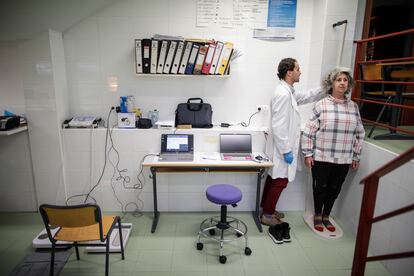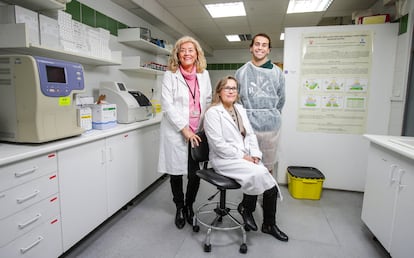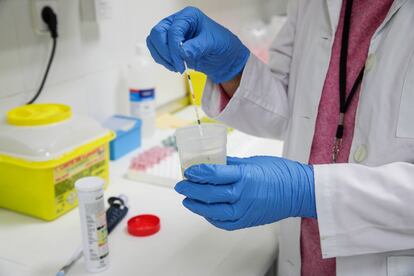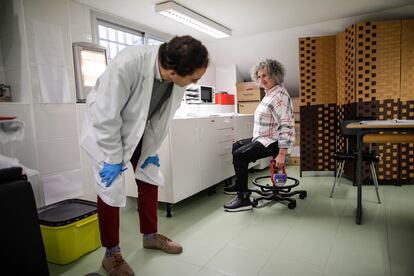Clinical trials: What’s it like to be a lab rat?
An EL PAÍS contributor takes part in an innovative study to test a nutritional supplement for overactive bladder syndrome

Before a product reaches the drugstore, various tests must be carried out. When a substance that could have therapeutic use is identified, it is first tested in cell cultures and animals, usually rats or mice. Experts analyze its possible toxicity, whether it causes serious adverse effects and its expected therapeutic efficacy. Once it has been proven that it is not toxic and does not cause serious problems, and after it has been shown to be effective in animal models, it is time for the final challenge: it is tested in human beings. This is known as a clinical trial.
Marcela González Gross, director of the Department of Health and Human Performance at the Technical University of Madrid, in Spain, directs a research group specialized in conducting clinical trials. “We have acquired a certain fame, both nationally and internationally,” she says. This reputation led an Icelandic company to reach out to them about doing a clinical trial with a nutritional supplement for overactive bladder syndrome.
This trial, which González Gross’s group started in 2020, aims to prove that a food supplement is effective against the symptoms of a syndrome that “12% of the population suffers from.” Overactive bladder syndrome causes a sudden and frequent need to urinate that can be difficult to control and whose complications, according to information from the Mayo Clinic, can even cause emotional suffering or depression, anxiety, sleep disturbances or sexual problems.
The clinical trial will analyze whether the supplement effectively ends this problem in 200 volunteers; including me.

An unpaid volunteer
I became part of the trial by chance. A researcher friend told me about it, and she explained that they were having trouble finding volunteers. I met the requirements, so I signed up. Spanish and European laws require that participation in a clinical trial be voluntary and unpaid. I had to fill out seven forms before starting the trial, from an informed consent, where I stated that I understood what the participation in the trial entails, to exhaustive inquiries regarding my urinary frequency, my lifestyle and my diet.
After providing all this information, my first day in the trial arrives. I must go to the biochemistry laboratory of the Faculty of Physical Activity and Sports Sciences of the Technical University of Madrid, where Jaime López-Seoane, a graduate in nutrition and dietetics and a PhD student, awaits. His thesis will focus precisely on this clinical trial, in which he is in charge of managing contact with the volunteers.

A voiding diary
The first thing they do is analyze my urine. Everything is fine, explains López-Seoane – there is no infection that could exclude me from the trial. Then, he explains my responsibilities: I must do what is known as a voiding diary.
For three days, every time I urinate, I will have to write down the time of urination, the degree of urgency I felt, if I leaked and the amount of urine, for which he gives me a little measuring jug. We both laugh at this, and he tells me that, once participation in the trial is over, some volunteers use it in the kitchen. “After all”, he says, “once it’s been in the dishwasher…” It does look like a perfect confectionery utensil. But before that happens, its job is to measure my urine.
I also have to make a record of all the liquids I drink throughout the day. It doesn’t seem complicated at all, just a bit tedious, especially when one is outside the house. “You will have to take the jug with you when you go out,” they explain. The first thing I think about are my plans for the next three days; also, if I have a bag large enough to carry it.
After journaling for three days, I will start to take the supplement. Two capsules a day. We decided that I will take them both in the morning, and we will see how things go.
Measurements and more measurements
After measuring my height and weight, as well as the amount and distribution of fat and muscle, I am given a fitness tests. The first one involves balance: I have to sit down and get up quickly, with my feet in a certain position and my hands on my shoulders. To my surprise, I do it quite well. The last one is a strength test in which I have to squeeze a device as hard as I can with each of my hands.
The tests of the state of my muscles have to do with overactive bladder syndrome itself. It is an idiopathic disease, which means that its causes are unknown. I wonder if maybe one goal of the trial is to find out if there is a connection between poor muscle tone (which doesn’t seem to be my case) and the syndrome.
After all the tests, López-Seoane hands me the bottle with the capsules that I will have to start taking in three days. It is a metal can with a label on which only my identifying number appears – this is completely anonymous – as well as the file and serial numbers of the product, the manufacturer’s name and a warning: “For clinical trial purposes only.”
What I do not know, nor does the person in charge of my trial, is whether or not the capsules that my bottle contains are from the supplement that is going to be tested, as the trial I’m participating in is randomized and double-blind. According to a previous clinical trial carried out in Iceland, it does seem to have beneficial effects for people suffering from overactive bladder syndrome.

In a clinical trial, half the volunteers receive the drug being tested, while the other half receives a placebo, a harmless substance with no effects whatsoever. The appearance is the same, but the content is not. This is necessary to be able to compare, at the end of the trial, if those who received the drug had any benefits compared to those who received the placebo.
Since this trial is double-blind, neither the researchers nor the volunteers know if the bottle contains the supplement or the placebo. These are the most rigorous clinical trials, because this avoids any biases that could alter the results. In addition, this is a random test, which means that the volunteers who will receive the placebo are also selected at random.
In six weeks, I will have my second appointment and Jaime will repeat all the tests from the first one. “It is essential to do this repetition under the same conditions so that the results obtained with the substance we are testing can be attributed, without a doubt, to the product itself,” explains López-Seoane. So, I will step on the scale and have my height, my strength and my balance measured again. I will fill out fluid intake and lifestyle forms, and I will make a new voiding diary during the three days prior to the appointment. Then my participation in the trial will be over. I will also find out if what I took was the product that is being tested or not. In a few weeks, I will tell you right here if I was lucky and didn’t get the placebo.
Sign up for our weekly newsletter to get more English-language news coverage from EL PAÍS USA Edition
Tu suscripción se está usando en otro dispositivo
¿Quieres añadir otro usuario a tu suscripción?
Si continúas leyendo en este dispositivo, no se podrá leer en el otro.
FlechaTu suscripción se está usando en otro dispositivo y solo puedes acceder a EL PAÍS desde un dispositivo a la vez.
Si quieres compartir tu cuenta, cambia tu suscripción a la modalidad Premium, así podrás añadir otro usuario. Cada uno accederá con su propia cuenta de email, lo que os permitirá personalizar vuestra experiencia en EL PAÍS.
¿Tienes una suscripción de empresa? Accede aquí para contratar más cuentas.
En el caso de no saber quién está usando tu cuenta, te recomendamos cambiar tu contraseña aquí.
Si decides continuar compartiendo tu cuenta, este mensaje se mostrará en tu dispositivo y en el de la otra persona que está usando tu cuenta de forma indefinida, afectando a tu experiencia de lectura. Puedes consultar aquí los términos y condiciones de la suscripción digital.
More information

How to cut a cake so everyone is happy
Últimas noticias
A survivor’s account of the Interoceanic Train accident: ‘We were scared because of the speed on the curve’
The Interoceanic Train, the Mexican alternative to the Panama Canal
What is known about the Interoceanic Train derailment in Oaxaca
Trump turns a Minnesota fraud allegation into ammunition for his MAGA army against Democrats
Most viewed
- Oona Chaplin: ‘I told James Cameron that I was living in a treehouse and starting a permaculture project with a friend’
- Reinhard Genzel, Nobel laureate in physics: ‘One-minute videos will never give you the truth’
- Why the price of coffee has skyrocketed: from Brazilian plantations to specialty coffee houses
- Pablo Escobar’s hippos: A serious environmental problem, 40 years on
- Chevy Chase, the beloved comedian who was a monster off camera: ‘Not everyone hated him, just the people who’ve worked with him’










































